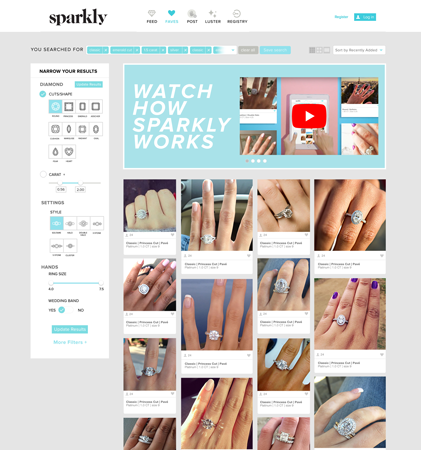People looking to propose face a conundrum: surprise your future fiancé and risk disappointment with your ring choice, or involve them in the process at the expense of the surprise.
Hollywood-based Sparkly believes it has solved the problem.
The company, which calls itself the Pinterest of engagement rings, allows users to browse rings based on the “four C’s”: carat, cut, clarity and color. Users can then filter photos to see their preferred rings on hands with similar dimensions to theirs.
Sparkly founder Steve Simon said the company’s website allows users to get a lot more detail compared with some other social media platforms or custom sites. The extra details can be used to curate a registry-like portfolio of their three preferred rings.
“You can browse photos of rings on Instagram, but you don’t really know what you like about them,” said Simon, a former Apple Inc. employee who founded Sparkly after going through the process of picking an engagement ring.
He said 70 percent of women are involved in the process of buying an engagement ring, so he wanted to “celebrate” that but preserve the element of surprise. Once the user is done creating their registry, they provide an email address of the one person who can access it. However, that person – typically a significant other – doesn’t know the registry exists.
“It’s sitting in the cloud waiting to be discovered.”
The discovery would come when a significant other begins to consider shopping for an engagement. Sparkly hopes the process will lead to its website, where visitors can enter their email address. Anyone whose would-be fiancé or fiancée has established a registry will hopefully discover it at that point.
The visitor can then unlock the registry by entering their name or email.
Simon said the goal is for Sparkly to be the go-to place for engagement rings, so buyers would likely check Sparkly to see if their significant other has created a registry. That hope would likely get a boost from the customers who create the registries – and might direct their significant others to Sparkly.
Simon and two partners have financed the company personally so far.
Simon said Sparkly has great potential as a lead generation tool for jewelers. But for now, Simon said the site is focused on gaining users, though the company would not provide any data.
“The foundation of the platform is the ability to filter and go look at photos,” he said. “We’re trying to disrupt this space and make it a fun and enjoyable process. It’s a celebration.”
Hot Potato?
One Potato, a Los Angeles-based meal kit company geared towards families, announced last week they are expanding to five new markets including Colorado, Idaho, Oregon, Washington and Utah.
The company operates currently in California, Arizona and Nevada and is funded by angel investors, including Alex Von Furstenberg, son of noted fashion designer Diane Von Furstenberg, according to a spokesperson.
The 18-month-old company does not disclose financials but employs 40 staff and contractors.
Chief Executive Catherine McCord said One Potato’s meals differ from competitors such as Blue Apron Holdings Inc. because they are semi-prepared and cut down on packaging, allowing families to prepare the meals in 15 to 30 minutes.
McCord said 75 percent of her customers have tried another meal company, fueling a belief that there’s plenty of room to differentiate from the rest of the market.
McCord also said the company is not concerned with news that Walmart Inc. is now selling meal kits, which caused publicly-traded Blue Apron shares to drop four percent in premarket trading on March 5.
“With Walmart, all they’re doing is pulling ingredients from their shelves and putting them in a box,” said McCord. “We’re semi-prepared.”
Out to Launch
Hawthorne-based Space Exploration Technologies Corp., or SpaceX, launched one of its Falcon 9 rockets at 12:33 a.m. EST on March 5.
The launch was originally set for Feb. 25 but delayed due performance concerns.
The launch took place at Cape Canaveral in Florida.
The rocket carried a Hispasat 30W-6 – the latest generation of a power commercial telecom satellite from Madrid, Spain-based Hispasat Group. The satellite Hispasat 30W-6, billed as the largest geosynchronous satellite payload to date, according to a tweet from SpaceX founder Elon Musk.
The satellite will be used for television, broadband and communications for corporate customers in Europe, North Africa and the Americas. SpaceX’s next launch is scheduled for March 29.
Staff reporter Eli Horowitz can be reached at [email protected] or at (323) 556-8335.

